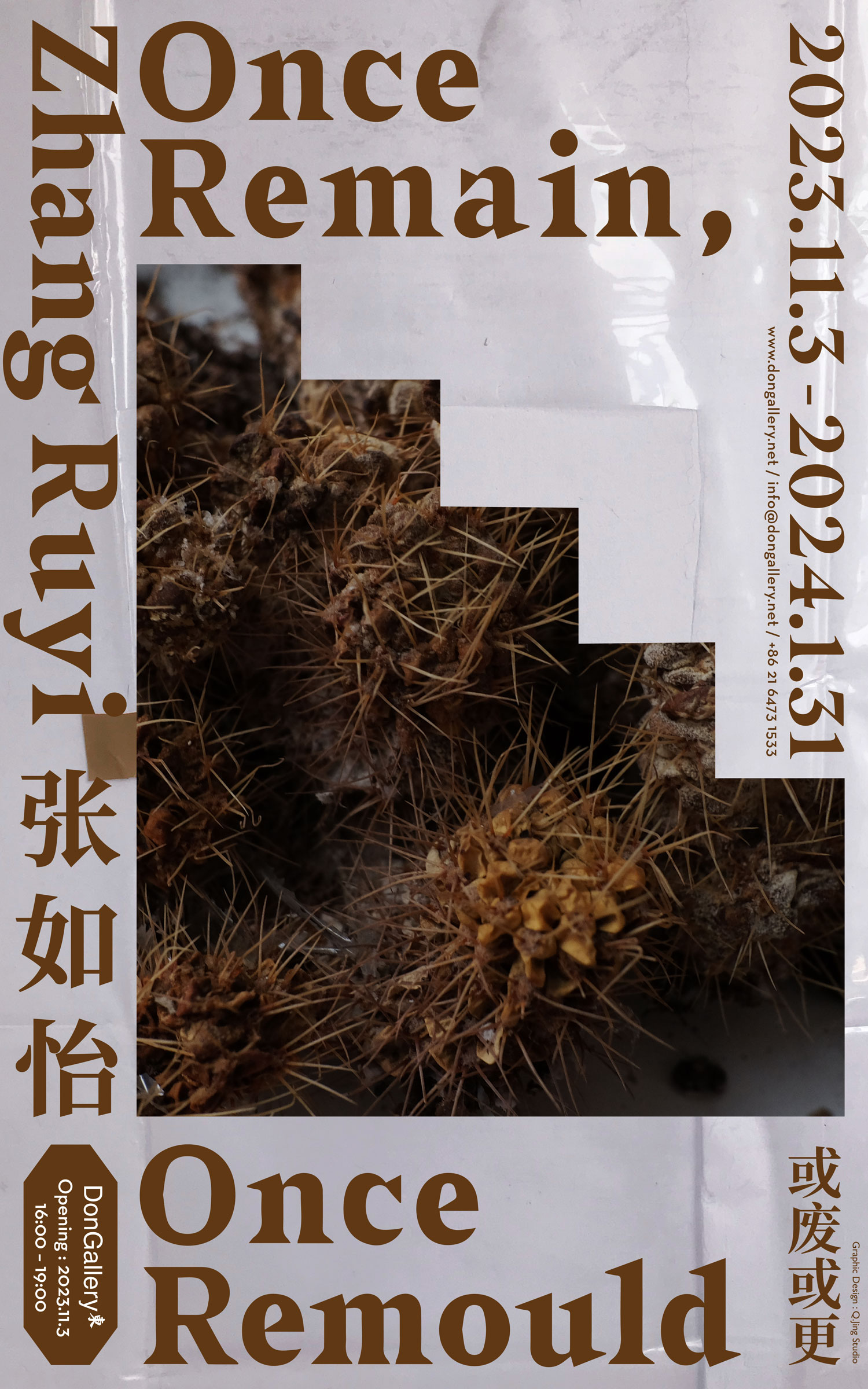展期 Period:
2023.11.3—2024.1.31
艺术家 Artist:
地点 Venue:
新闻稿 Press Release:
东画廊欣然宣布将于2023年11月3日举办艺术家张如怡个展“或废或更”(Once Remain, Once Remould),展期至2024年1月31日。本次展览是艺术家继2019年“以为何处”之后于东画廊举办的又一次个人展览,也是其在画廊的第四次个展,将展出全新的平面与雕塑作品。展览题目的灵感来自于张如怡对于城市更新与空间吐纳的观察。在这个日益野蛮的时代,艺术家继续审视周遭的损弃之物,以介于建设与破坏之间的创作来强调当代生活的未定形式。
张如怡在创作了标志性的混凝土雕塑之后,发现了城市建材的灵活性。作品《兼捕尘埃》提供了一种上下连通的视野,这个悬挂物就像是城市的肢体,是一个摆脱了功能逻辑的空间附属物。作品本身的质地与意象以矛盾性的方式唤起人们所熟悉的观看城市绿植的体验。相对应地,以常见的货运铁板为灵感的作品《失修的缓坡》为视觉的攀升提供了低调的戏剧性。马赛克仙人掌的严谨构图一如既往地反映出张如怡对于工业性道具的着迷。张如怡的装置制造了不可介入的活动痕迹,如同一个登台的戏剧场景。或者,更准确地说,是一个正在抬升的工业场景的切片。连接画廊前后空间的是《种植-7》:它具有艺术家偏爱的璧龛形式,内嵌的水泥神祇与倾斜的墙面将观众的视线引入人造的薄膜圆厅。
在圆形展厅中,张如怡将私密性的浪漫与公共性的强迫推至了舞台的核心。致密的薄膜、胶带、鱼缸、残缺的门框、不断循环的影像:观众将在变幻无常的光影之中遭遇现代社会的“沙砾”。这一环形景观与美学的不确定性相呼应,它既像一个正在装修中的家宅工地,又像一个保留了生活残影的废弃旧居。在展览中,张如怡以两种程序反思生活与搭建生活的雕塑。其一是碎片化,其二是实物的裸露过程。譬如,在《易逝的现代-2》中,微倾的钢筋、碎砖与倒扣的椅面影射了建筑师勒·柯布西耶的萨伏伊别墅:现代主义洁净立面的内里是钢筋的穿刺。
张如怡的创作深受街道内外的启发,这表现为对于马路遗弃物的热爱和对于特定装修耗材的归属感的揣测。这构成了其作品的“家族形象”,让人们联想到这些“或废或更”之物的原生环境。她的作品向来是城市新陈代谢的比拟物。从根本上说,这种揣测更是一首哀歌,是一首献给衰老的城市的哀歌。《提取切片-2》为观看展览的观众提供了一句断章:在门框的前后、内外、左右,隐匿于实体周围的纯粹空间邀请人们细察公私关系的彼此渗透。
罗莎琳•克劳斯(Rosalind E. Krauss)在《现代雕塑的变迁》(1977)末章中,详细描述了极简主义者们的要旨:“……它把一切都押在了含义模式的准确性上……”。她认为,这些艺术家反对雕塑中的错觉主义:比如,把石头变成肉体,将雕塑变为隐喻。在本次展览“或废或更”中,张如怡尝试了一种大胆的综合:让错觉在极简的排布中达到巅峰,为城市隐喻匹配适当的浓缩。
文/夏天
Don Gallery is pleased to announce the opening of ZHANG Ruyi’s solo exhibition "Once Remain, Once Remould", which will run from November 3, 2023 through January 31, 2024. This is the artist's fourth solo exhibition at Don Gallery, following "Consciousness of Location" in 2019. It will feature a series of brand-new sculptures and two dimensional pieces. The title of the exhibition is inspired by ZHANG Ruyi's observations of urban renewal and spatial exhalation. In an era of increasing savagery, the artist continues to examine the detritus that surrounds her, emphasising the undefined forms of contemporary life with creations that lie somewhere between construction and destruction.
ZHANG Ruyi discovered the flexibility of urban building materials after creating her iconic concrete sculptures. The work Bycatch the Dust offers an up-and-down view of a hanging object that acts as a limb of the city, a spatial appendage freed from its functional logic. The texture and imagery of the work itself paradoxically evokes the familiar experience of looking at urban greenery. Correspondingly, Dilapidated Gently Sloping, inspired by the common freight iron plate, provides an understated drama to the visual climb. The austere composition of the mosaic cactus reflects, as always, ZHANG Ruyi's fascination with industrial props. ZHANG Ruyi's installation creates traces of uninvolved activity, like a theatre stage. Or, more accurately, a slice of a rising industrial scene. Linking the space in front of and behind the gallery is Planter-7: it takes the form of a niche favoured by the artist, with embedded concrete deities and tilted walls that lead the viewer's eye into a man-made, plastic films rotunda.
In the rotunda, ZHANG Ruyi pushes the romance of privacy and the compulsion of publicity to the centre of the stage. Dense plastic films, tapes, fish tanks, mutilated door frames, and constantly looping images: the viewer encounters the "gravel" of modern society in an ever-changing landscape of light and shadow. This circular landscape echoes the uncertainty of aesthetics, as it resembles both a home construction site under renovation and an old abandoned house that retains the remnants of life. In the exhibition, ZHANG Ruyi reflects on life and builds sculptures of it in two procedures. One is fragmentation, and the other is the process of exposing physical objects. For example, in Perishable Modernity-2, the slightly tilted steel bars, broken bricks and inverted chair allude to Le Corbusier's Villa Savoye: a modernist clean façade lined with pierced steel bars.
ZHANG Ruyi's work is deeply inspired by the street and beyond, which manifests itself in a love of abandoned objects on the road and a speculation about the sense of belonging of specific renovation consumables. This forms the "family image" of her work, reminding people of the original environment of these remains or remould objects. Her work has always been an analogue of urban metabolism. In essence, this speculation is a dirge, a dirge for the aging city. Extracting Slices-2 offers the viewer of the exhibition an epigraph: in front of and behind the doorframe, inside and outside, left and right, the sheer space surrounding the hidden entity invites one to scrutinise the interpenetration of public and private relations.
Rosalind E. Krauss, in the closing chapter of The Passages in Modern Sculpture (1977), describes in detail the gist of what the minimalists were all about: '…it staked everything on the accuracy of a meaning…'. She argues that these artists rejected illusionism in sculpture: turning stone into flesh, for example, and sculpture into metaphor. In the coming exhibition, "Once Remain, Once Remould", ZHANG Ruyi attempts a bold synthesis: letting illusion reach its peak in a minimalist arrangement, Matching urban metaphors to appropriate condensation.
Text / XIA Tian

